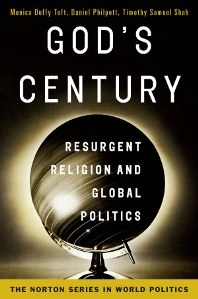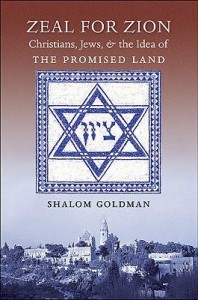Contemporary Church History Quarterly
Volume 27, Number 4 (December 2021)
Webinar Note: Humanitarian Entanglements: A Report on Recent Research on Mennonite Central Committee, Mennonite Refugees, and the Legacies of National Socialism, November 4, 2021
By Alain Epp Weaver, MCC
Since its inception in the second half of the nineteenth century, modern humanitarianism has operated within fields of power, with humanitarian actors seeking to carve out space to carry out their work in accordance with their principles such as impartiality and neutrality. Humanitarian practice has always run the danger of becoming entangled in different ways with government agendas and with the complicated histories of individuals and communities displaced by war that humanitarian agencies seek to assist. On November 4, 2021, a group of historians gathered at a virtual roundtable convened by the University of Winnipeg on the theme, “Mennonite Central Committee, Refugees, and the Legacies of National Socialism,” to discuss one example of such humanitarian entanglements before, during, and after the Second World War. The roundtable built on the fall 2021 issue of Intersections (a publication of Mennonite Central Committee, or MCC), that featured examinations by 12 historians from Canada, the United States, Paraguay, France, Germany, and the Netherlands of the complex ways in which MCC, as a Christian humanitarian agency, interacted and was bound up with Nazism and its legacy from the 1930s into the mid-1950s. Several articles featured in Intersections benefited from extensive consultation of MCC’s archives in Akron, Pennsylvania.
At the roundtable, four authors from the Intersections issue highlighted key findings from their research on MCC’s postwar resettlement efforts with displaced Mennonites, with Anna Holian, author of a landmark study of uprooted groups in Germany after WWII, offering a response.[1] This roundtable also drew on sustained scholarly attention from the past few years on transnational Mennonite intersections, entanglements, and even complicity with Nazism in the 1930s and 1940s.[2] This brief report highlights findings from both the November 4 roundtable and the fall 2021 issue of Intersections, outlining the various ways that MCC entanglements with Nazism were bound up with broader Mennonite entanglements with Nazism.
MCC’s entanglements with National Socialism emerged as a byproduct of the organization’s efforts to assist Mennonites seeking to leave the Soviet Union.[3] MCC was founded by Mennonite churches in the United States in 1920 to respond to the call of Mennonites in southern Russia (soon to become part of the Soviet Union) who, along with their neighbors, faced both war and a devastating famine. In the first half of the 1920s, MCC operated feeding and agricultural development programs in parts of southern Russia home to Mennonite communities. While MCC distributed humanitarian assistance, other actors, such as the Canadian Mennonite Board of Colonization (CMBC), worked to help Soviet Mennonites migrate to Canada, with Soviet officials sometimes suspecting MCC of supporting and encouraging such migration efforts.[4]
The conditions facing Soviet Mennonite communities progressively worsened in the 1920s, with the Soviet state dispossessing Mennonite landholders and imposing increasingly strict restrictions on religious expression. By 1929, the situation had worsened to the point that up to 15,000 German-speaking Soviet citizens (Mennonites, but also Catholic, Lutherans, and others) descended on Moscow to demand that they be allowed to migrate. This pressure eventually led to 4,000 Mennonites receiving permission to leave the Soviet Union for Germany—with financial loans from the German government (guaranteed by MCC), these Mennonites then migrated to Paraguay where, with MCC assistance, they established the Fernheim colony in the country’s Gran Chaco region.
MCC’s entanglements with National Socialism emerged from this period. Once the Nazis assumed power in Germany in 1933, MCC de facto became a debtor to the Nazi government. To help with negotiations with the German government to postpone payment on this debt, MCC relied on pro-Nazi Mennonites, including Benjamin Unruh (one of the Mennonites from Russia who had appealed to U.S. Mennonites for help in 1920 and who had ended up in Germany).[5]
Strongly anti-Communist, Unruh also dreamed of Mennonite settlement in eastern European lands to be conquered by the Nazis and helped nourish the hopes of some in the Mennonite Fernheim colony in Paraguay of a return to Europe following anticipated Nazi victories. MCC grew increasingly concerned throughout the 1930s and into the war years by the growing pro-Nazi feeling within this Paraguayan Mennonite colony it had helped to set up and continued to support. MCC sought to nurture commitment to the traditional Mennonite doctrine of nonresistance among Fernheim’s colonists, while also avoiding direct involvement in Fernheim’s governance. However, once the tension within Fernheim between the völkische (German nationalist) and wehrlose (unarmed, or nonresistant) factions erupted into violent conflict in 1944, MCC, under pressure from the U.S. government, in turn pushed colony leadership to expel the völkische leaders.[6]
Mennonites and other groups classified as German by the Soviet authorities faced sustained and harsh persecution under the Stalinist regime in the 1930s, including the deportation of half of the Mennonite population from what is now Ukraine to Siberia. The Nazi occupation of Soviet Ukraine in 1942 brought a reprieve for Mennonites and others identified as Volksdeutsche who were viewed favorably within the Nazi racialized hierarchy. During the Nazi occupation period, not only did Mennonites receive favored treatment, but some also actively implemented Nazi genocidal policies, including the massacre of Soviet Jews.[7]
As German forces retreated from the Soviet Union, many Soviet Mennonites fled with them. Nazi authorities settled some of these Mennonites in Germany and some in occupied Poland, depending on how ideologically trustworthy the Nazis viewed specific individuals. Mennonite men of eligible age served in German military units; some served in the Waffen-SS and in the paramilitary death squads of the Einsatzgruppen. These displaced Mennonites received houses and other goods stolen by Nazi authorities from Poles, Jews, and others. The vast majority of these displaced Mennonites accepted German citizenship.
After the Allied defeat of Nazi forces, these displaced Mennonites found themselves in a precarious situation, under threat during the first couple years after the war of deportation back to the Soviet Union. [And, in fact, around half of these displaced Mennonites were returned to the Soviet Union, where they faced a deeply precarious future.] Mennonite refugees seeking options within the emerging postwar international refugee system had multiple strikes against them—their acceptance of German citizenship, service in the German military, and the assessment by international refugee bodies that Mennonites had left the Soviet Union voluntarily.
Alongside broader postwar humanitarian efforts, including active participation in the joint efforts of the Council of Relief Agencies Licensed to Operate in Germany (CRALOG), MCC worked to assist displaced Soviet Mennonites (along with Mennonites from the Danzig/Vistula Delta region who had fled after the war) and to help them migrate to the Americas (especially Canada and Paraguay). To counter the strikes that displaced Mennonites had against them, MCC workers advanced different arguments in different contexts, making a variety of arguments regarding Mennonite “nationality” (e.g., that they were Dutch, or that Mennonites should be viewed as having their own nationality, similar to Jews), contending that Mennonites had been coerced into accepting German citizenship, and downplaying Mennonite participation in Nazi military bodies. When one argument failed, MCC staff advanced others in their sustained lobbying efforts for Mennonite refugees. Over the course of the decade following the war, MCC succeeded in resettling around 15,000 displaced European Mennonites in the Americas, including approximately 12,000 Mennonites from the Soviet Union.[8]
The University of Winnipeg’s November 2021 roundtable on “Mennonite Central Committee, Refugees, and the Legacies of National Socialism,” chaired by Ben Nobbs-Thiessen, the co-director of the university’s Centre for Transnational Mennonite Studies, examined this latter part of the story of MCC entanglements with Nazism, with four historians who contributed to the fall 2021 issue of Intersections briefly sharing key highlights from their research.
Benjamin W. Goossen, affiliated with Harvard University, initiated the roundtable with remarks underscoring the importance of contextualizing Mennonite and MCC entanglements with Nazism within broader and longer histories of Mennonite antisemitism. Goossen highlighted how antisemitic attitudes can be found in the writings of leading anti-Nazi Mennonites in the United States, Canada and Europe—not only among overtly pro-Nazi Mennonites. MCC’s postwar comparison of Mennonites to Jews, deployed as part of efforts to secure Mennonite migration, was, Goossen contended, disingenuous, covering over the complex, multifaceted ways that Soviet Mennonites had not only benefited from Nazism but had in different ways been actively complicit with it, including, in some cases, participation in the Holocaust. The postwar public narrative promulgated by MCC workers among Mennonite communities in Canada and the United States of the providential, Exodus-like rescue of a persecuted Mennonite community not only grossly simplified a much more complicated reality but also chilled Mennonite postwar grappling with legacies of antisemitism and investigation into Mennonite involvement in Nazism’s genocidal program.
Many MCC workers in postwar Europe expended considerable time and effort to convince groups such as the Intergovernmental Committee on Refugees (IGCR) and the International Refugee Organization (IRO) of Soviet Mennonite eligibility to migrate from Europe (and to receive international assistance to do so). In her presentation, Erika Weidemann of Texas A&M University traced how IGCR officials debated internally about Soviet Mennonite eligibility for Displaced Persons (DP) status and examined the evolving arguments MCC workers advanced to convince the IGCR and IRO of that eligibility. On the whole, Weidemann noted, these MCC efforts proved successful. International refugee bodies sought to articulate an unambiguous approach to Soviet Mennonite refugees, but in practice the approach was constantly shifting, with MCC adjusting to those shifts in its efforts to interpret Mennonites to international refugee agencies and to advocate for their favorable treatment.
Steve Schroeder of the University of the Fraser Valley focused his intervention on MCC’s assistance to uprooted Mennonites from the Danzig/Vistula Delta region. To help secure Mennonite emigration from Europe, Schroeder explained, MCC workers argued that Danziger Mennonites had an identity that transcended Germanness and portrayed these Mennonites as victims. In reality, Schroeder continued, these Mennonites had fully assimilated into German society decades before the war.[9] During the war, Danziger Mennonites voluntarily served in the army, some worked as concentration camp guards, and some used enslaved labor from concentration camps on their farms. Like Goossen, Schroeder underscored how MCC’s constructed narratives about displaced Danziger Mennonites contributed to and furthered a distorted narrative of European Mennonites having been removed from or above the fray of the war (or of having been victims of the war), a narrative that covered over the varied forms of Danziger (and broader European) Mennonite complicity with Nazism.
The final panelist, the University of Winnipeg’s Aileen Friesen, began by urging historians to recall the individual toll of the Holocaust, naming the individuals murdered by people carrying out Nazism’s genocidal program. On the Yad Vashem website, one can search the towns and villages in Ukraine once home to large Mennonite communities like Molochansk and find the names of Jewish people like Maria Sheffer and Mendel Ioffe who were murdered in the Holocaust. Friesen discussed how MCC’s postwar attempts to present Soviet Mennonites as having “Dutch” nationality was a reinvention of older arguments and discussion about where Mennonites fit into the emerging order of nation-states. Drawing from her Intersections article, Friesen suggested that the assessment of international refugee organizations after the war that Mennonites had left the Soviet Union “voluntarily” did not square with how the Mennonite refugees perceived their departure. Interpreting Soviet Mennonite actions during the Nazi war-time occupation and as German forces retreated cannot, Friesen stressed, be divorced from the backdrop of two decades of increasingly harsh persecution faced by Soviet Mennonites.
Building on her research in MCC’s archives, Friesen discussed how MCC workers providing humanitarian assistance to displaced Soviet Mennonites sought to make sense of those Mennonites as they learned about the ways those Mennonites had been entangled and had collaborated with Soviet authorities and then with the Nazi regime. Tensions among displaced Mennonites in MCC-operated camps in post-war Germany simmered and sometimes erupted with recriminations about different forms of collaboration. The response of MCC workers as they learned in piecemeal fashion of these Mennonite entanglements with both Soviet communism and Nazism was to “let it all go”—rather than seeking to establish a true account of what choices different individuals under MCC’s care had made during the war, MCC instead focused on constructing general accounts of Mennonite victimhood in efforts to secure Mennonite emigration from Erope. This hands-off MCC approach enabled someone like Heinrich Wiebe, who served as mayor of Zaporizhzhia during the German occupation, to present himself to MCC and CMBC as a pillar of the Mennonite community who had remained distant from Nazism, when in fact he had been involved in the ghettoization of the city’s Jewish population and the expropriation of their property and was active as mayor when the city’s security apparatus, which included Mennonites among its leaders, executed the city’s remaining Jews in 1942.
In her response to the panel, Anna Holian of Arizona State University placed MCC’s postwar refugee resettlement efforts within the broader context of the emerging international refugee regime in which “nationality” functioned as the key concept. Holian explained that in this postwar system, one’s “nationality” (understood in both political and cultural terms) determined where one supposedly belonged, even if that was not where one had previously lived or was where one wished to be. Mennonites were not the only group seeking to classify themselves as a distinct nationality as they sought favorable outcomes for themselves in this postwar system: Jews and Ukrainians also sought to disentangle themselves from other national identities.
Holian’s response and the discussion that followed pointed to questions for further research: How did MCC postwar work with displaced Mennonites change over time? How did MCC understand (or fail to understand) the Mennonites whom it sought to assist? Mennonites were not free of the varied forms of antisemitism that marked Christianity in Europe, the United States, and Canada—what role did that antisemitism play in MCC (and broader Mennonite) entanglements with Nazism? To what extent did MCC shape or dictate Mennonite refugee narratives about themselves and their war-time experiences—and to what extent were MCC narratives about these Mennonite refugees shaped by how the refugees narrated their experiences to MCC? The rich conversation at the November 2021 roundtable on these and other questions highlighted that much fertile scholarly ground remains to be explored regarding Mennonite and MCC entanglements with Nazism and its legacies before, during, and after the Second World War.
Alain Epp Weaver directs strategic planning for Mennonite Central Committee. He is the author of Service and the Ministry of Reconciliation: A Missiological History of Mennonite Central Committee, C.H. Wedel Series No. 21 (North Newton, KS: Bethel College, 2020).
Notes:
[1] Anna Holian, Between National Socialism and Soviet Communism: Displaced Persons in Postwar Germany (Ann Arbor, MI: University of Michigan Press, 2011).
[2][2] See especially Benjamin W. Goossen, Chosen Nation: Mennonites and Germany in a Global Era (Princeton: Princeton University Press, 2017) and Mark Jantzen and John D. Thiesen, eds., European Mennonites and the Holocaust (Toronto: University of Toronto Press, 2020).
[3] For an analytical overview of MCC entanglements with National Socialism, see Benjamin W. Goossen, “MCC and Nazsim, 1929-1955,” Intersections 9/4 (Fall 2021):
[4] Esther Epp-Tiessen, “MCC and Mennonite Emigration from the Soviet Union, 1920-1932,” Intersections 9/4 (Fall 2021): 13-17.
[5] Arnold Neufeldt-Fast, “Benjamin Unruh, Nazism, and MCC,” Intersections 9/4 (Fall 2021): 17-27.
[6] See John Eicher, Exiled among Nations: German and Mennonite Mythologies in a Transnational Age (Cambridge, UK: Cambridge University Press, 2019); Eicher, “MCC and Nazi Impressions of Paraguay’s Mennonite Colonies in the 1930s and 1940s,” Intersections 9/4 (Fall 2021): 27-32; John D. Thiesen, Mennonite and Nazi? Attitudes Among Mennonite Colonists in Latin America, 1933-1945 (Kitchener, ON: Pandora Press, 1999); Daniel Stahl, “How the Fernheimers Learned to Speak about the Nazi Era: The Long Historical Echo of a Conflict,” Mennonite Quarterly Review 92/2 (April 2018): 285-298; Stahl, “Paraguay’s Mennonites and the Struggle against Fascism: A Global Historical Approach to the Nazi Era,” Mennonite Quarterly Review 92/2 (April 2018): 273-284; and Stahl, “Between German Fascism and U.S. Imperialism: MCC and Paraguayan Mennonites of Fernheim during the Second World War,” Intersections 9/4 (Fall 2022): 32-35.
[7] See Martin Dean, “Soviet Ethnic Germans and the Holocaust in the Reich Holocaust in the Reich Commissariat Ukraine,” in The Shoah in Ukraine: History, Testimony, Memorialization, ed. Ray Brandon and Wendy Lower (Bloomington: Indiana University Press, 2010), 248–71 and Aileen Friesen, “A Portrait of Khortytsya/Zaporizhzhia under Occupation,” in European Mennonites and the Holocaust, ed. Mark Janzen and John D. Thiesen (Toronto: University of Toronto Press, 2020), 229–249.
[8] For examinations of MCC’s efforts to resettle displaced Mennonites after the Second World War, see Ted Regehr, “Of Dutch or German Ancestry? Mennonite Refugees, MCC, and the International Refugee Organization,” Journal of Mennonite Studies (1995): 7-25; Benjamin W. Goossen, “MCC and Nazism, 1929-1955,” Intersections 9/4 (Fall 2021): 3-12; Erika Weidemann, “Identity and Complicity: The Post-World War II Immigration of Chortitza Mennonites,” in European Mennonites and the Holocaust, ed. Mark Jantzen and John D. Thiesen (Toronto: University of Toronto Press, 2020), 269-289; Weidemann, “Facing the Future, Reinterpreting the Past: MCC’s Solutions for Successful Mennonite Immigration after the Second World War,” Intersections 9/4 (Fall 2021): 45-50; Aileen Friesen, “Defining the Deserving: MCC and Mennonite Refugees from the Soviet Union after World War II,” Intersections 9/4 (Fall 2021): 50-54; Steven Schroeder, “National Socialism and MCC’s Post-War Resettlement Work with Danziger Mennonites,” Intersections 9/4 (Fall 2021): 54-60; and John D. Thiesen, “John Kroeker and the Backstory to the ‘Berlin Exodus,’” Intersections 9/4 (Fall 2021): 40-45.
[9] See Mark Jantzen, Mennonite German Soldiers: Nation, Religion, and Family in the Prussian East, 1772–1880 (Notre Dame, IN: University of Notre Dame Press, 2010).

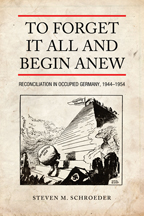 Unlike most of the studies of postwar Germany that focus on the origins of the Cold War and high stakes political maneuvering of the Allies, Schroeder takes a bottom-up approach that illuminates the less conspicuous reconciliation work of German groups such as the Association of the Victim of Nazism (VVN) and religiously-affiliated international groups such as International Fellowship of Reconciliation (IFOR), Moral Re-Armament (MRA), Pax Chrisiti, the International Council of Christians and Jews (ICCJ), and the World Council of Churches (WCC). His study compares and contrasts reconciliation, defined as “the establishment of peaceful – or at least non-hostile – relations between former enemies” in the four zones of occupation in the immediate postwar years and in East and West Germany after 1949.
Unlike most of the studies of postwar Germany that focus on the origins of the Cold War and high stakes political maneuvering of the Allies, Schroeder takes a bottom-up approach that illuminates the less conspicuous reconciliation work of German groups such as the Association of the Victim of Nazism (VVN) and religiously-affiliated international groups such as International Fellowship of Reconciliation (IFOR), Moral Re-Armament (MRA), Pax Chrisiti, the International Council of Christians and Jews (ICCJ), and the World Council of Churches (WCC). His study compares and contrasts reconciliation, defined as “the establishment of peaceful – or at least non-hostile – relations between former enemies” in the four zones of occupation in the immediate postwar years and in East and West Germany after 1949.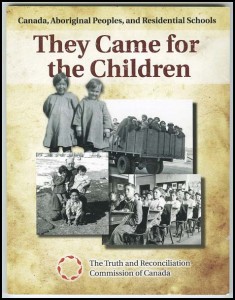 The book explains how the churches in Canada began their missionary work of converting Aboriginals to Christianity and to western cultural practices long before confederation. This foundation proved useful to Canadian government officials who found accord with the church leaders’ intent “to civilize and Christianize” Aboriginal children.
The book explains how the churches in Canada began their missionary work of converting Aboriginals to Christianity and to western cultural practices long before confederation. This foundation proved useful to Canadian government officials who found accord with the church leaders’ intent “to civilize and Christianize” Aboriginal children.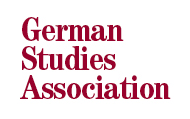 Once again this past year, the German Studies Association conference included a number of interesting panels or papers devoted to contemporary church history.
Once again this past year, the German Studies Association conference included a number of interesting panels or papers devoted to contemporary church history.